Jajangmyeon is a very popular noodle dish in Korea that is made with Chinese black bean paste (Chunjang), meat and veggies. A great one-dish meal any time or any day of the week!
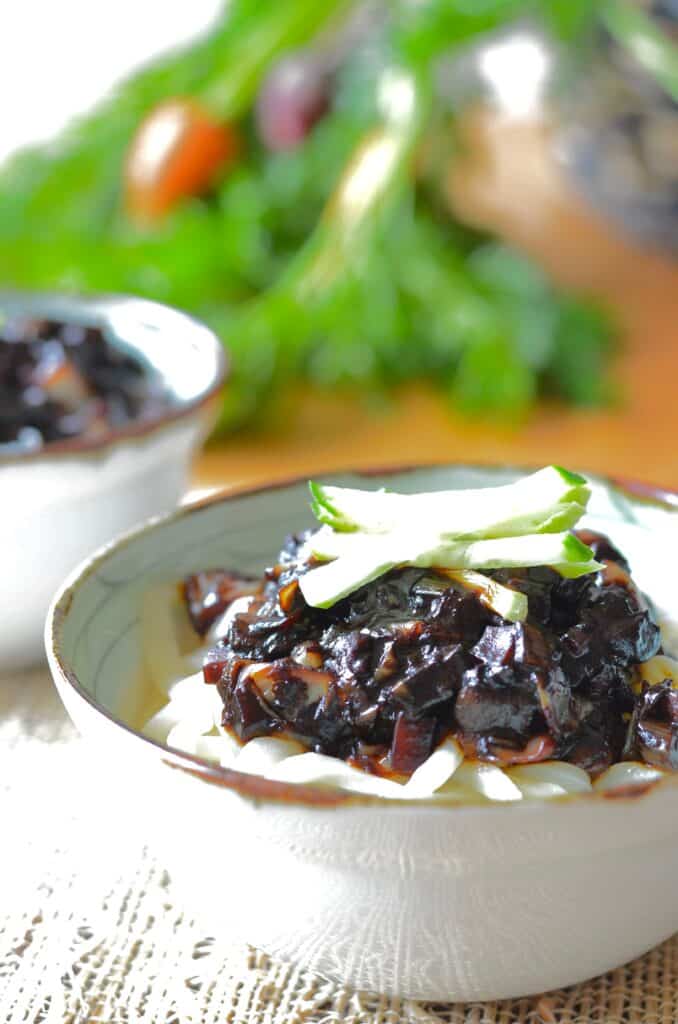
What is Jajangmyeon?
Jajangmyeon (짜장면) or Jjajangmyeon is a Chinese Korean noodle dish that is topped with a thick savory black bean sauce with meat and/or seafood and vegetables. This dish is very popular among Koreans, especially children because it’s not spicy but delicious.
The noodles for this dish was traditionally hand-pulled and thus called Suta Jajangmyeon 수타 짜장면. Hand-pulled means that you pull and stretch the dough and fold and repeat until you get hundreds of thin strands of the dough. Unfortunately, the fresh hand-pulled noodles are very hard to find anymore.
I have been making this dish at home since 91′ after I got married (over 20 years?!) at the request of my husband. My recipe has evolved quite a bit over the years and I have to say I’m quite happy with this one. When I gave it to my daughter for tasting, she happily chanted “Your Jajangmyeon tastes better than the one at the restaurant we visited!”. And if you are allergic to MSG, my version does NOT need any so you are good there.
History of Jajangmyeon
According to one story was introduced in 1905 by a Chinese chef at Gonghwachun (공화춘; 共和春), a Chinese restaurant in Incheon Chinatown settled by early Chinese immigrants from the Shandong Province of China. Since then, it has fully become part of the Korean culture, invoking all sorts of memories for many Koreans young and old.
The other story says that no one knows for certain who introduced it first but the dish came about because the Chinese immigrants who worked at the Incheon pier in the 1890’s needed something quick and cheap to eat.
In 2012, I visited Incheon and also visited the Jajangmyeon museum and here are some pictures that I took.
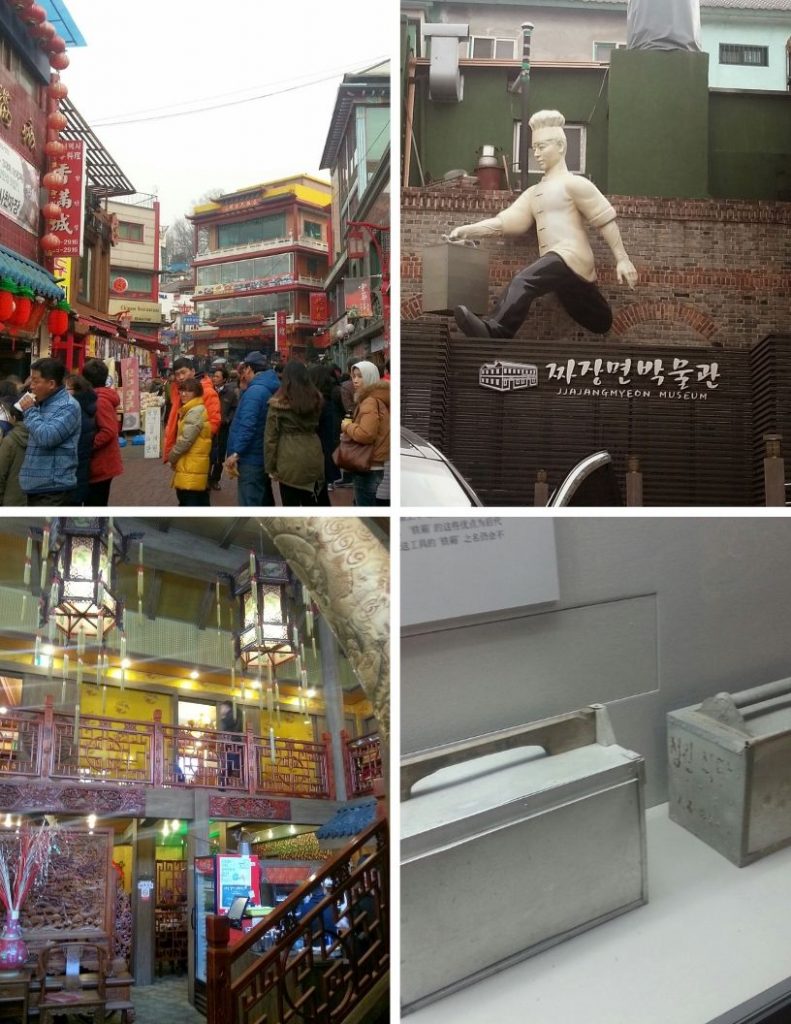
From top left to right: picture of Incheon Chinatown and tourists; the chef + delivery man sculpture in front of the museum; the inside of the most famous Jajangmyeon restaurant (feels like I was in a Chinese martial arts movie); antique steel carrier used for delivering Chinese food.
So… also did you ever notice? In almost every Korean drama, you will see characters devour this black sauce noodle dish-ending with black sauce all around their mouths. And they are always delivered in a version of the steel carrier above which is now sometimes a plastic box.
There’s even a saying among Koreans about how a move to a new home is not complete unless you order Jajangmyeon at the end of a long moving day. For every Korean neighborhood, there’s always a Chinese restaurant nearby and delivery is a must. A few days ago, in one of my TV favorite show – “Dad, where are you going?“(아빠 어디가? Appa Uh-diga?)- I watched this yummy black noodles being delivered to a rice field!!? Whaat??? Even the dads were surprised to see the food when it came. Now, I call that service!!!
I think in many ways, this noodle dish is equivalent to America’s Pizza. If you are up late working in the office or if you have friends over but not sure what to eat, then Koreans order this ultimate comforting dish.
Why do you eat Jajangmyeon on Black Day 4/14th?
So you know about 2/14 being Valentine’s Day. In Korea, there’s an additional day called White Day on 3/14th. So Valentine’s day is when Korean girls buy gifts for boys they like. White Day is for the boys to buy girls gifts. Well.. then what about singles??
Well, Korean singles decided to make 4/14th Black Day!! And on this Black day, singles get together wearing black and eating something black. And Jajangmyeon is the most popular black food to eat this day. I think it also has to do with the fact that you can’t help get your face all messy eating this black noodle dish and if you are a single, what do you care?? LOL.. at least that’s my take on it.
Types of Black Bean Sauce Noodles
- 간짜장면 Gan-Jajangmyeon – more intense flavor because the sauce is condensed (just black bean paste and vegetables, little water) also more expensive
- 짜장면 Jajangmyeon – water or broth added to Gan Jajang, so it’s milder in flavor
- 삼선간짜장면 Samseon-Gan-Jajangmyeon – ‘sam’ means 3 and ‘seon’ means taste. Traditionally, it contains 3 kinds of seafood like squid, sea cucumber and shrimp in addition to pork and veggies.
- 사천짜장면 Sahcheon-Jajangmyeon – Sahcheon (사천) means Szechuan. as with many things Szechuan, it had added spiciness
- 유니짜장면 Uni-Jajangmyeon – is made with ground meat instead of cubes which is how it’s mostly done
- 쟁반 짜장면 Jaengban Jajangmyeon – this is a large shareable noodles served in a round tray (Jaengban)
Best Noodles for Jajangmyeon
The best kind of noodles are the hand-pulled noodles of course by professional Chinese chefs. And then the next best thing is to make my fresh noodles at home. Check out my Kalguksu post on how to make your own noodles. These noodles are not only great for Kalguksu but also works perfectly for this Korean black bean sauce noodles.
Store Bought Noodles
Buy one’s that says “짜장면 국수” but 생칼국수 (Kalguksu/Kalgooksoo) will work too. I buy one from Pulmuone like this one but others work all pretty well. You can also sometimes use 우동 Udon noodles too but just choose one that’s not too thick.
In a pinch, you can even make it with Spaghetti noodles.

Vegan Jajangmyeon
To make your Jajangmyeon vegan, just omit meat and seafood but cut up tofu into little cubes first then pan-fry them in oil until the outside is nicely browned and crispy. Use this browned tofu instead of meat in your recipe and it will still be delicious!
Chef’s Tips
- Always pre-fry the Chunjang in lots of oil – if you skip this step, your sauce will come out tasting a bit tart
- Customize added ingredients – you can add or swap out vegetables. Many like to add potato and I personally don’t like it but totally up to you. Just don’t omit onions. You can also add squid, shrimps or scallops to the recipe below. Use BEEF stew meat instead of pork if you’d like
- Make extra sauce – it keeps for several days in the fridge so just reheat and enjoy later.
- Use rice instead of noodles to make Jajangbap or better yet, make simple fried rice and serve it with that.
- Add a runny fried egg on top for extra umami!
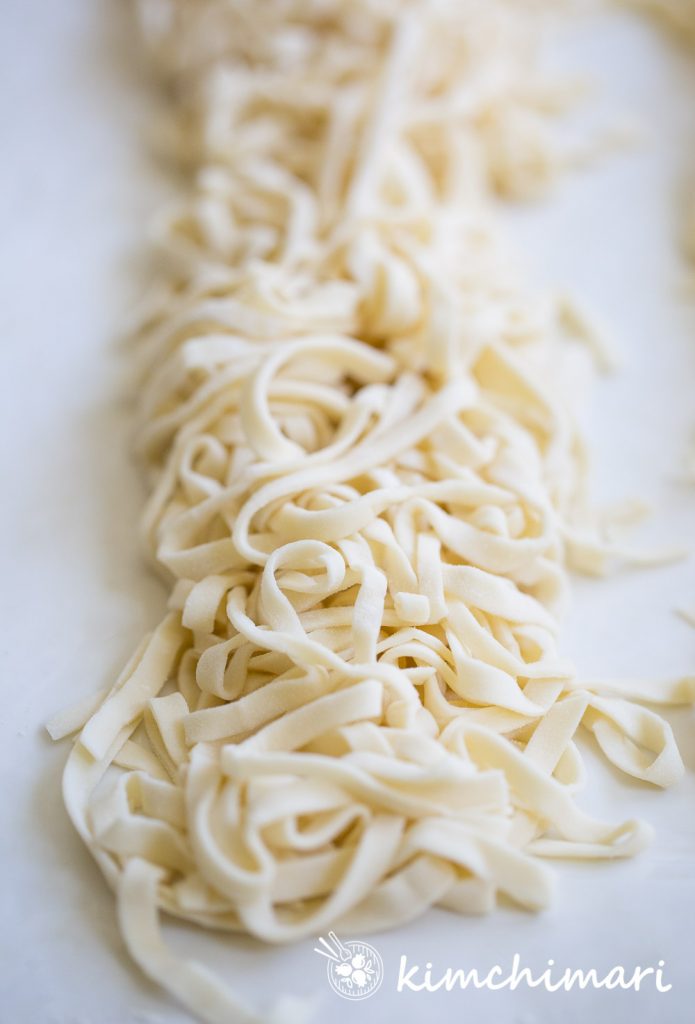
I’ve tried it with this Jjajang sauce and it was AMAZING!! Just make sure to rinse the cooked noodles in cold water and drain.
Step-by-Step Instructions
Servings: 3 Cooking Time: 35 min Difficulty: Medium
Ingredients
- 1 pack of fresh noodles for Jajangmyeon or kal guksu (or homemade)
- 1/2 cup Chinese black bean paste (춘장 chunjang/choonjang)
- 1/3 cup vegetable oil (for sauteeing chunjang)
- 3 Tbs vegetable oil (for sauteeing veg)
- 1/2 cup or 3 fresh, dried or fresh shitake mushrooms, chopped (optional)
- 3 oz (80g) pork loin or pork belly cut into cubes
- 1 medium size onion, chopped
- 1 1/2 cup cabbage, chopped
- 1/2 cup zucchini, chopped
- 1 carrot, chopped (optional)
- 2 green onions, chopped
- 1/2 cucumber, julienned (as garnish)
- 1 Tbs sugar
- 1 cup water
- Cornstarch slurry – 1/4 cup water + 1 Tbs cornstarch
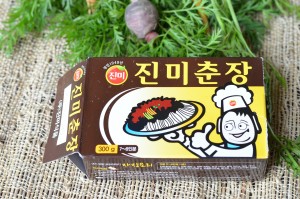
In Korea, this Jinmi Chunjang (진미 춘장) is the standard black bean paste used. There are other brands like ShingSong 신송, CJ and they are all similar. There’s also a pre-fried version called Bokkeun Jajang and you can use that one too but I find it doesn’t really replace the step of sauteeing it with oil. They used to have MSG in it but not any more so that’s a good thing. 🙂 READ HERE to learn more about this ingredient.
- Start boiling a pot of water to cook the noodles. If using store-bought noodles, cook according to package directions. Usually 7-10 minutes. See my note on noodles above. Or, if you made your own homemade noodles with my Kalguksu recipe, then follow direction over there. But rinse and drain the noodles in cold water when they are cooked. Set aside.
- Prepare ingredients below:

2. Chop all vegetables and pork into small cubes. Julienne cucumbers to use as garnish.

3. In a non-stick frying pan, add an equal amount of chunjang and oil to pan on medium/medium-low heat. Should be bubbling but not burning. Stirring often, cook for 7 min.
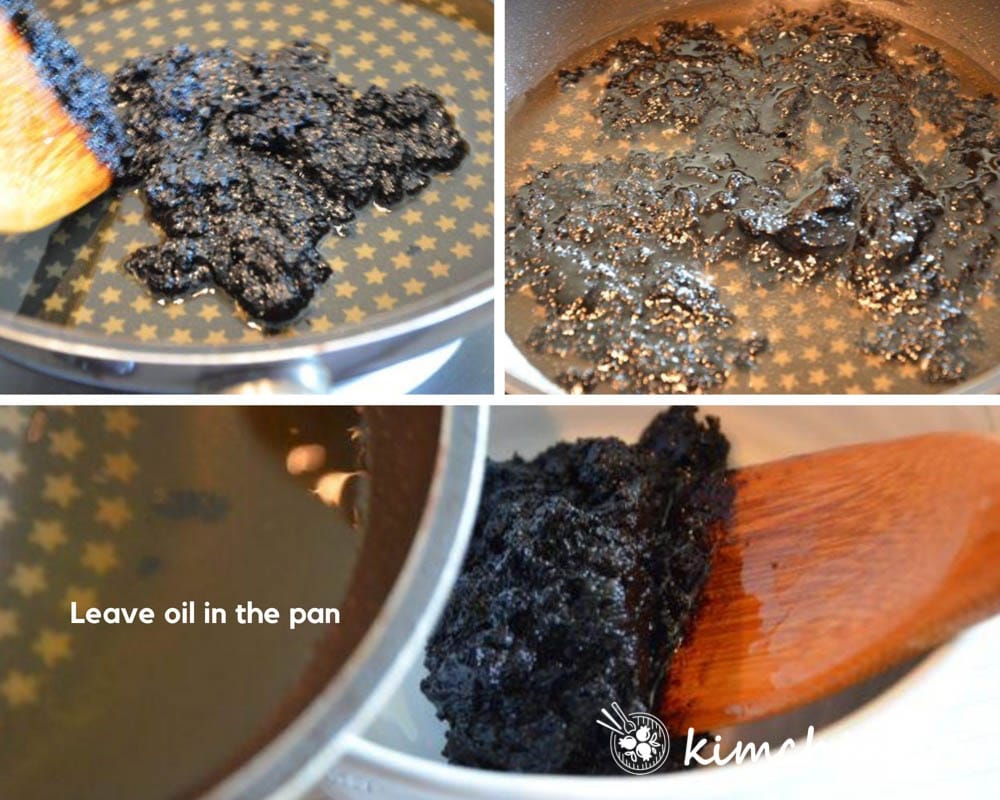
Lots of oil will be leftover after stir-frying the paste. Remove chunjang from pan. It should be easy to bunch up the cooked chunjang and remove from oil. Discard leftover oil in the pan.
4. WHILE the chunjang is cooking, in ANOTHER pan, add 2 T oil to pan on medium heat. Sauté just onions and cabbages for 10 min or more until onions become translucent. This will make your sauce taste sweeter!
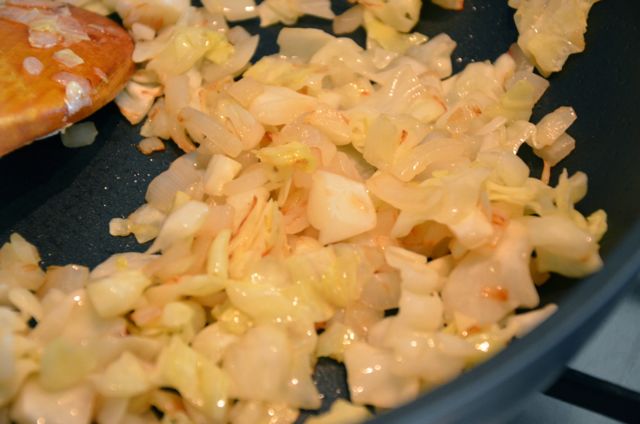
5. Remove onions and cabbages from pan and set aside. Sauté pork on med-high heat for 2-3 min in the same pan.
6. Once pork is cooked, return onions, cabbages to pan. Add 1 T oil and remaining vegetables. Sauté all ingredients on med-high heat for 5 – 7 min. Veggies should still be slightly crunchy.
7. Add the sauteed chunjang paste to pan and stir everything, making sure the paste coats the ingredients evenly.

8. Stir fry for 2 min. Add 1 cup water or chicken broth and 1 Tbs sugar. Mix and simmer for 1-2 min.
9. Add the cornstarch slurry and stir. Keep stirring for 2-3 min. until the sauce thickens. Alternatively, to make Gan Jjajangmyeon, omit the slurry and just cook until the sauce is reduced to half. Reduce further for more condensed flavor.
10. Sauce is now ready!

Just add noodles or rice to a bowl and top with this amazingly yummy sauce, garnish with some julienned cucumbers.
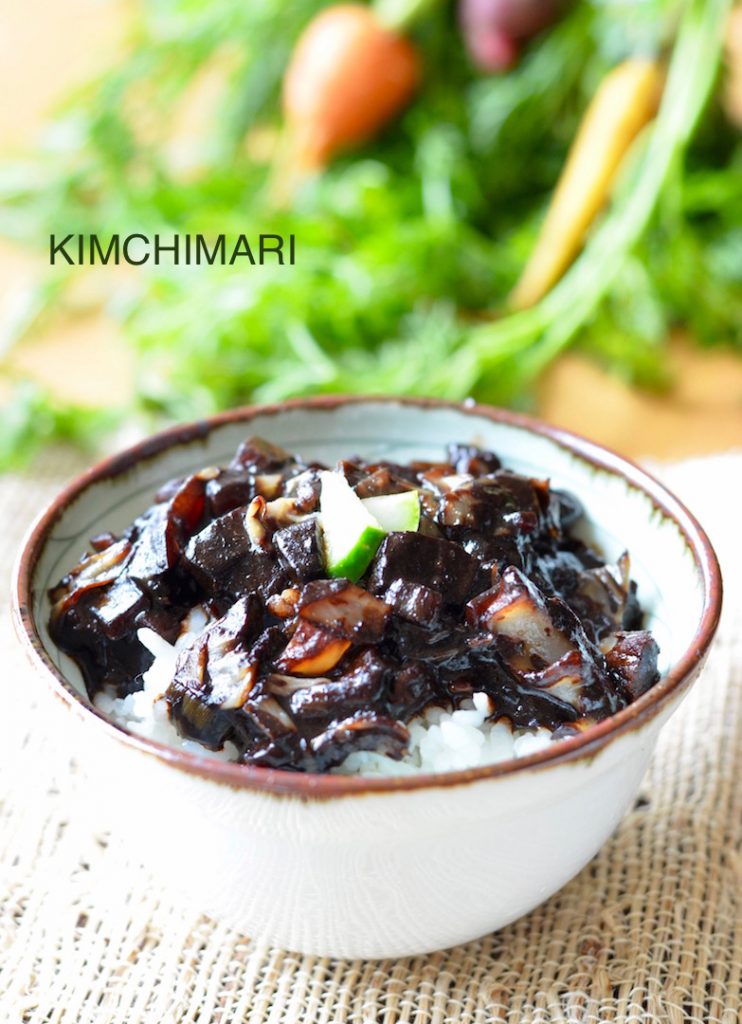
NOTES
- How to make Gan Jajangmyeon? – In step 8, instead of adding cornstarch slurry just reduce the sauce until it’s reduced by 1/2.
- Chunjang(춘장) and Jajang(짜장) are used interchangeably when referring to the black bean paste. Sometimes you may find 볶음짜장(bokkeum jajang) which means it’s already been fried in oil in which case you can skip step 3.
- For a richer sauce, use chicken broth instead of water. Watch out for saltiness though since chicken broth already has quite a bit of sodium. Use low sodium chicken broth or use half broth and half water.
SERVING SUGGESTIONS
- Serve a side of Danmuji 단무지 (Yellow pickled radish) and some fresh onions slices with the chunjang as a dipping sauce. These two sides are a must.. Oh and Kimchi too!
- Make Gyeran Guk (Korean egg drop soup) and serve together – especially when you are serving rice with black bean sauce.
Jajangmyeon (Blackbean Sauce Noodles)
Ingredients
Noodles
- 3 servings fresh noodles for jajangmyeon or kal guksu
For Sauteeing Black Bean Paste
- 1/2 cup Chinese black bean paste (춘장 chunjang/choonjang)
- 1/3 cup vegetable oil
To finish sauce
- 1 medium size onion , chopped
- 1 1/2 cup cabbage , chopped
- 5 oz pork loin, cut into cubes
- 1/2 cup or 3 fresh , dried or fresh shitake mushrooms, chopped (optional)
- 1/2 cup zucchini , chopped
- 1 carrot , chopped (optional)
- 2 green onions , chopped
- 1 Tbsp sugar
- 1 cup water or chicken broth
Cornstarch slurry (optional – omit for Gan Jjajangmyeon)
- 1 Tbsp cornstarch
- 1/4 cup water
Garnish
- 1/2 cucumber , julienned
- 3-4 Tbsp vegetable oil
Instructions
Noodles
- Boil a pot of water for noodles. Cook noodles in boiling water for 7-10 min (based on package directions) and rinse in cold water.
- NOTE – Fresh noodles are best. You can buy one’s that says “짜장면 국수” or "칼국수"(Kalguksu/Kalgooksoo) – both work fine. You can also make your own homemade fresh noodles by following my recipe in my Kalguksu post.
Prep Ingredients
- Chop all vegetables and meat into small cubes. Julienne cucumbers to add as garnish.
Make Sauteed Chunjang
- In a non-stick frying pan, add equal amount of chunjang and oil to pan on medium/medium low heat. Stir often, cook for 7 min.
- Remove chunjang from pan. It should be easy to bunch up the cooked chunjang and remove from oil. Discard the leftover oil in pan.
Make Sauce
- In ANOTHER pan, add 2 T oil to pan on medium heat. Sauté onions and cabbages for 10 min or more until onions become translucent.
- Remove onions and cabbages from pan and set aside. Sauté pork on med-high heat for 2-3 min in the same pan.
- Once pork is cooked, return onions, cabbages to pan. Add 1 T oil and remaining vegetables. Sauté all ingredients on med-high heat for 5 – 7 min. Veggies should still be slightly crunchy.
- Add cooked chunjang paste to pan and stir everything, making sure the paste coats the ingredients evenly.
- Stir fry for 2 min. Add 1 C water and 1 T sugar. Mix. Simmer fro 3-4 min.
- Add the cornstarch slurry and stir for 2-3 min. It's ready when sauce has thickened to a little thicker than gravy consistency. Omit this step and just reduce the sauce to make a more conentrated Gan Jjajangmyeon.
- Serve noodles topped with sauce and then some julienned cucumbers.
Tips & Notes:
- Substitute white rice or leftover fried rice for noodles for Jajangbap.
- Substitute chicken or beef for pork if you’d like.
- For richer sauce, use chicken broth but watch for salt content.
- Serve with some Kimchi or Danmuji 단무지 (pickled yellow radish) and some raw onions with uncooked chunjang.

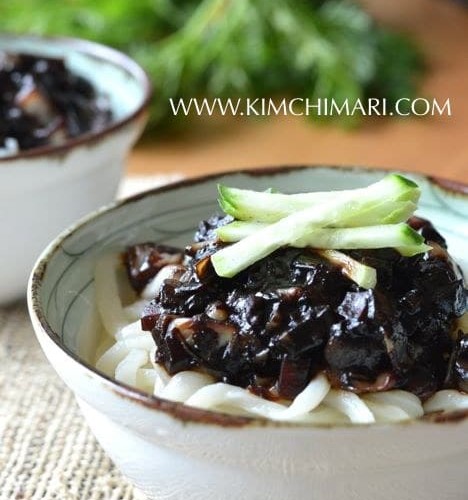
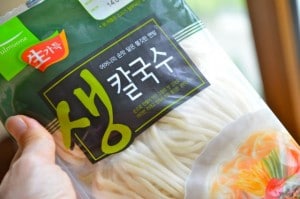

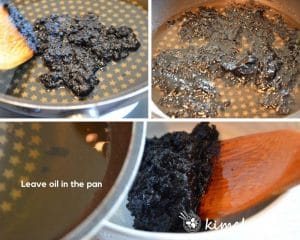
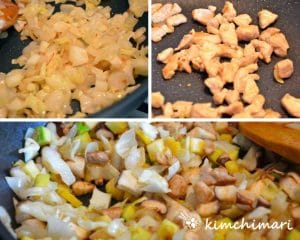
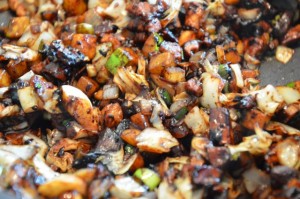

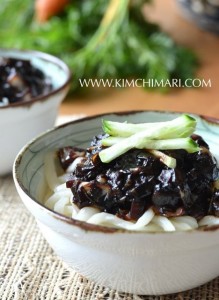
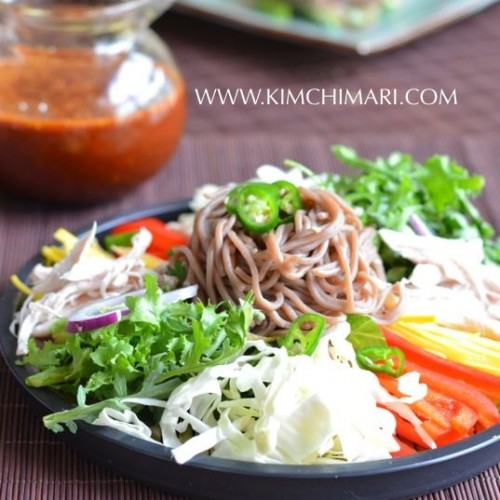
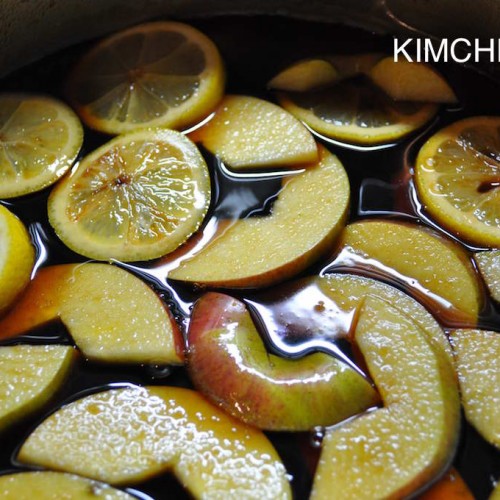
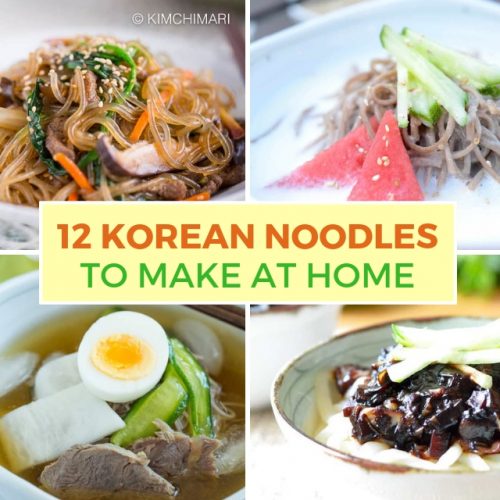

















I would love to try 짜장면, your receipe sounds so yummy (!) – but I have celiac disease and can’t eat any wheat. Is there a way I can make the noodles myself without wheat (if you have a receipe, I would love it) or do you know if it is possible to buy gluten free 짜장면 noodles without the instant sauce to go with it?
Hi Nick, I’m sorry but I don’t yet have a recipe for gf jjajangmyeon noodles. you could just buy gf bucatini or spaghetti noodles and use that instead? I don’t think there’s gf 짜장면 noodles – instant or not… sorry I can’t be of much help. Also just FYI, the 짜장 sauce will most likely contain wheat..
This is my new favorite Korean recipe! So easy to prepare and the flavor is amazing.
Great!! So happy to hear that! enjoy!
Thank you for the recipe, I cooked it and it tasted very good. Instead of pork, I used beef. Thats so yummy.
I’m so happy to hear that!! Yes, we make it with beef often because my husband is kinda allergic to pork. Thank you!!
I’m going to try this recipe but leave out the meat….. hope your sister continues to improve by leaps and bounds; you certainly got her on the road to good health.🥰
Aww thank you soo much Sally. Really appreciate your kind thoughts. She is doing better each day and now I’m back home. And if you want to leave out the meat, try frying tofu cubes in oil then adding it to the sauce in lieu of meat. It works well!